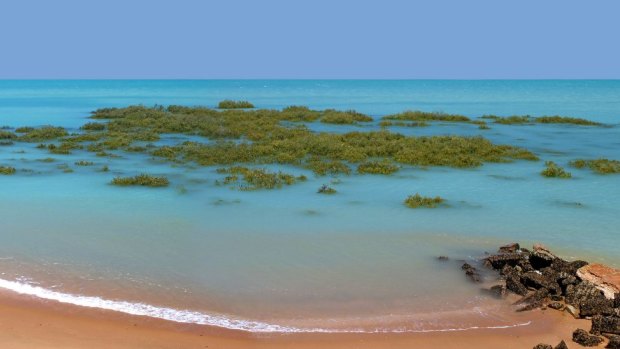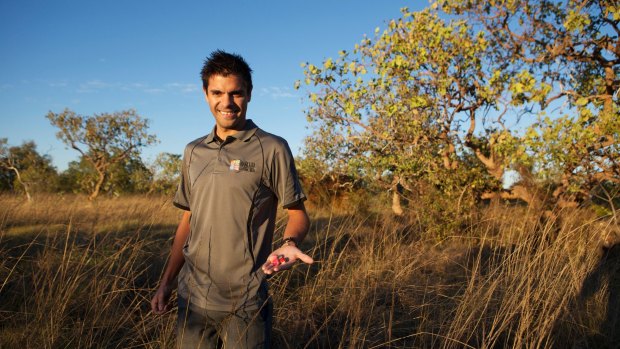This was published 6 years ago
Broome, Kimberley: Australia's 'Dinosaur Coast' has one of the world's finest beaches
By Steve Meacham

Roebuck Bay, Kimberley.Credit: Alamy
On this gorgeous autumnal morning – with temperatures still in their high 20s – most visitors to Broome's world-famous Cable Beach are focused on the ocean. Some are swimming, others fishing while several ute drivers are launching boats from the firm, flat, endless sands. Still more are taking selfies with the surf in the background.
We, however, are going on a dinosaur hunt and we're not scared – largely because these dinosaurs have been dead for at least 130 million years.
Bart Pigram, our Indigenous guide, is a Yawuru man, born in Broome. He guides us to an outcrop of exposed flat rock that would be under water at high tide, and asks us if we can spot anything unusual.

Bart Pigram, an Indigenous guide in Western Australia's far north, is a Yawuru man, born in Broome.
Eventually he puts us out of our misery and shows us some of the footprints left behind in the mudflats long before homo sapiens walked this earth.
This part of Western Australia's far north – where the desert meets the sea – is sometimes called "the Dinosaur Coast". International visitors tend to be much better informed about its archaeological significance than Australians. However that might not be a bad thing since around 20 different types of dinosaur have been identified here on what used to be part of a river plain on the vast prehistoric continent known as Gondwanaland, and now it is one of the finest tourist beaches in the world.
As the personable Pigram explains, there are two main types of dinosaur prints here in Broome. There's the fat, vaguely circular footprint of a heavy herbivore. And the smaller "three-toed" print that is altogether more scary since it signifies a "beast-footed carnivore".
"This is a theropod track," Pigram says as he pours water into what only a moment ago had seemed like an insignificant indentation. "I found this a couple of weeks ago when it was exposed by the tides."
Scientists only discovered "the Dinosaur Coast" in the past century, but Pigram's ancestors have been living in Australia for perhaps 60,000 years and he's an expert in Australia's rich indigenous "saltwater culture".
His father is singer/songwriter with the Pigram Brothers, one of the Kimberley's most celebrated Indigenous country/folk groups. And the younger Pigram's purpose in showing us the dinosaur tracks is steeped in "black fella" heritage.
"These theropod tracks go up and down this coast in both directions," Pigram tells us. "Gularrbulu people [from the west of Australia] believe they were made by Marala, the giant Emu Man, who walked all the way down from the north (of the Dampier Peninsula) to Broome, creating laws relating to country."
Looking at these huge emu-like tracks, spaced widely apart, it's hardly surprising today an ancient people would imagine a giant creature, half emu, half man.
Just south of Gantheaume Point, Marala apparently came across seven women. The senior woman told the others not to look at the Emu Man, and turned them all to stone when they did, sending their spirits up into the sky where they now form the Pleiades, the seven sisters.
"Marala himself was being tracked, so he leapt upwards and and became the "Emu In The Sky" [a dark shape in the Milky Way between stars that is a vital part of Aboriginal astronomy]."
To be honest, I'm not sure what sounds more far-fetched – a giant Emu Man who left identifiable footprints? Or vast creatures the size of a double-decker bus wiped out by a meteorite on the other side of the world?
Pigram's people were involved in the Rubibi Native Title Claim which followed the landmark Mabo decision of the High Court of Australia in 1992. Now huge hectares of this part of the western Kimberley are back in Indigenous ownership.
Pigram, a father of four who looks 10 years younger than he is, launched Narlijia Tours in 2015. The official translation for "narlijia", according to his website is "true to you" in the Yawuru language. However Pigram in person comes up with a different interpretation.
"Narlijia means 'no bullshit'," he says. "My family has been here for generations. I strip back all that glossy crap, and tell the truth."
That becomes apparent several times on our walk. One of his guided walks explores the heritage areas around Gantheaume Point lighthouse and Chinatown. Very little remains of the original settlements now, but Pigram brings the areas alive with his stories of how the Yawuru/Djugun people lived before white people arrived, how their natural springs were taken over by the colonisers and called "nigger wells", how the pearling industry was sustained by the opium dens, brothels and gambling houses that made Broome one of the most lawless and lively towns in Australia in the early 1900s.
Our "Beach to Bay" mangrove tour, however, concentrates more on the town's rich Indigenous heritage. At one point he shows us what looks like a single bush, but which contains two very different plants.
Abrus precatorius – or crab's eye bean – makes great beads and percussion instruments but is fatal when eaten: "Bush poison, full of arsenic," says Pigram. "We tell all our children when they are very young to avoid it."
And yet its neighbour – "we call it galalamburr" – is "a native cure for toothache and joint pains if you strip its bark and release the alkaloids".
Our walk concludes on what Pigram calls Didirrgun, or Kennedy Hill (a few metres from the four-star Mangrove Resort Hotel). This is a gigantic midden on a hilltop overlooking Roebuck Bay, piled high with millions of discarded shells.
"These shells have been brought up here for generations," Pigram says. "The shellfish were eaten as our ancestors watched the moon rising." He picks up a couple of shells. "This is a pipi shell, and this is a cockle shell. But for some reason, we don't get cockles here in Broome any more.
"I think it's sad I can't bring my kids to collect cockles as my dad taught me when I was a kid. But at least we've still got plenty of mud crabs."
His favourite fish? "Probably Gidid (Maori sea perch)." What about barramundi? "That shit? We don't even have a word for it in my language."
Soon we're on the subject of some of his favourite meat: goanna. Several times a year he and a few mates will go on goanna hunts. "Beautiful tucker," he explains. "The texture is a bit like crocodile.
"You've got to singe the skin off first, then gut it. Then you pack its insides with tea tree leaves, put it in the coals of an underground oven that's a bit like a Maori hangi. An hour later you'll have a meal which will feed five with full bellies."
He shows us a few photos on his smartphone, holding goannas he's caught – and they're giants.
Our tour concludes here on Kennedy Hill. But only after Pigram tells us another Dreaming story about why so many of those cliffs on the other side of Roebuck Bay are blood-coloured and why there are so many water sources near them.
After he's cleared up some of the bottles, cans and cigarette packets on the Dreaming site, he points to "Buccaneer Rock" which can be reached on foot at low tide.
As each full moon sets over the Indian Ocean in the clear-sky season, Broome experiences an aquatic phenomenon known as "Staircase to the Moon" when a ladder of moonlit ripples seems to lead across the ocean.
"I finish the tour on Buccaneer Rock on those nights," Pigram says. "We sit down and have a couple of beers while I play the guitar. It beats watching the Staircase from the Mangrove Hotel."
TRIP NOTES
TOUR
Narlijia Tours' Beach to Bay tour costs $125, for tour times and dates, see toursbroome.com.au
STAY
Cable Beach Club Resort and Spa, Broome: www.cablebeachclub.com
FLY
QantasLink has direct flights to Broome from Melbourne, Sydney, Brisbane and Perth. Virgin Australia has direct flights to Broome from Melbourne.
MORE
traveller.com.au/western-australia
Steve Meacham travelled as a guest of Tourism Western Australia.
Sign up for the Traveller Deals newsletter
Get exclusive travel deals delivered straight to your inbox. Sign up now.